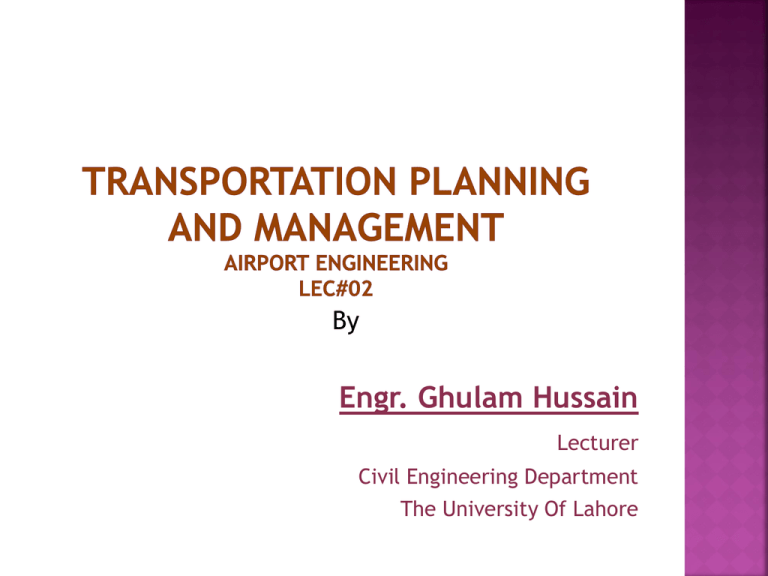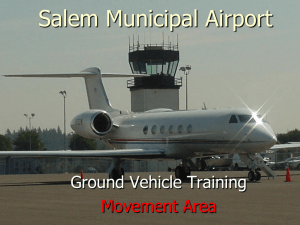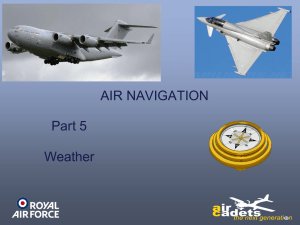Transportation Engineering and Planning
advertisement

By Engr. Ghulam Hussain Lecturer Civil Engineering Department The University Of Lahore Single runway Parallel runways Open-V runways Intersecting runways There are several important aircraft operational characteristics to know about the aircraft mass. Aircraft mass expenditures are significant and thus need to be accounted for in the air vehicle runway length analysis. OEW = operating empty weight (or mass) is the weight (or mass) of the aircraft without fuel and payload (just the pilots and empty seats) MTOW = maximum takeoff operating weight (or mass) - structurally the maximum demonstrated mass at takeoff for safe flight (excludes run-up fuel and includes OEW, fuel & Payload). Longer trips requires more fuel with less payload MALW = maximum allowable landing weight (or mass) is the maximum demonstrated landing weight (or mass) to keep the landing gear intact at maximum sink rate (vertical speed) MSPW = maximum structural payload weight (or mass) is the maximum demonstrated payload to be carried without stressing the aircraft fuselage MZFW = maximum zero fuel weight (or mass) is the sum of the OEW and the MSPW MTW = maximum taxi weight (or mass) of the maximum demonstrated weight (or mass) for ground maneuvering. Usually slightly more than MTOW (includes run-up fuel). DTW = desired takeoff weight (or mass) is the weight of the aircraft considering fuel (includes reserve), payload and OEW to complete a given stage length (trip distance) DTW = PYL + OEW + FW (trip fuel + reserve) where: PYL is the payload carried (passengers and cargo) OEW is the operating empty weight FW is the fuel weight to be carried (usually includes reserve fuel) Selecting the length of runway is perhaps the important decision which must be made in the planning of landing area. Length of runway mainly depends on The type of aircraft Its payload Trip length (fuel weight) Altitude and temperature at the airport Safety regulations It is the length of runway under the following assumed condition at the airport: Airport altitude at sea level Temperature at airport is standard (150 c) Runway is leveled in the longitudinal direction No wind is blowing on runway Runway surface is dry Aircraft is loaded at its full loading capacity Corrections to basic runway length Aircraft Type Takeoff (ft.) Landing (ft.) B747-200B 10,500 6,150 DC-10-30 10,490 5,960 Concorde 10,280 8,000 B727-200 10,080 4,800 A300 B4 8,740 5,590 B737-200 6,550 4,290 DC-9-50 7,880 4,680 F28-2000 5,490 3,540 F27-500 5,470 3,290 SD3-30 3,900 3,400 FS = full strength pavement distance CL = clearway distance SW = stop way distance FL = field length (FS+SW+CL) LOD = lift off distance TOR = takeoff run TOD = takeoff distance LD = landing distance SD = stopping distance D35 = distance to clear an 11 m (35 ft.) obstacle DAS = distance to accelerate and stop (ASD) Runway in future discussion refers to full strength pavement (FS) - Support the full weight of the aircraft For turbine aircraft the regulation do not requires FS for the entire Take-off Distance (TOD), while for piston aircraft requires FS for entire TOD Runway Field Length (FL) have three basic components Full strength pavement (FS) Clearways (CL) Stopways (SW) Clearway (CL) Rectangular area beyond the runway not less than 500 ft. wide and not longer than 1000 ft. Extends from end of runway with a slope not exceeding 1.25 percent above which no object protrude except for the threshold lights on two sides of the runway (not higher than 26 inches) Allowing aircraft to climb safely to clear an imaginary 11 m (35 ft. obstacle) Stopway (SW) Area beyond runway, width not less than runway Paved surface that allows aircraft to stop in situation of abandoned takeoff (engine failure in turbine powered is not very common) Permit use of lesser strength pavement for turbine powered, while for piston aircraft requires FS for entire SW The following cases are considered for determining the basic runway length Normal takeoff (all engines working fine) Engine-out takeoff condition Continued takeoff Aborted takeoff Landing The cases which works out the longest runway length is finally adopted The normal landing case requires that an air craft should come to a stop within 60% of the landing distance. The runway of full strength pavement is provided for the entire landing distance. Stop Runway 60% of landing distance Landing distance The landing distance should be 67% longer than the demonstrated distance to stop an aircraft The normal take-off case requires a clearway which is an area beyond the runway and is in alignment with the centre line of runway. The width of clearway is not <150m and is kept free form obstruction. The clearway ground area or any object on it should not protrude a plane inclined upward at a slope of 1.25% from the runway. Normal Takeoff Case clearway Clearway ≤ ½ of this distance 10.5m height Lift-off distance 115% of Lift-off distance Distance to 10.5m height 115% of distance to 10.5m height ( take-off distance) Longitudinal section Plan Normal Take-off Case Clearway Min150m Runway Normal Takeoff Case CL is min. 500 ft. wide with a grade less than 1.25 deg. Dictated Continued takeoff sub case by two scenarios: Actual distance to clear an imaginary 11 m (35 ft) obstacle D35 (with an engine-out) Aborted or rejected takeoff sub case Distance to accelerate and stop (DAS) Engine Out Analysis * * Decision speed is the speed chosen by the aircraft captain in relation to the respective limitations of the aircraft, the airline operator rules and procedures, runway characteristics and actual meteorological conditions Clearway ≤ ½ of this distance Engine Failure Decelerated – stop distance 10.5m height Stop way Lift-off distance Clear way Accelerated stop distance Distance to 10.5m height ( take-of distance ) Longitudinal section Runway Plan Engine Failure Case Stop way Min150m Clear way Lengths for the critical aircraft: Case 1: Normal take-off Case 2: Engine-failure take-off Case 3: Eng. -failure aborted take-off Case 4: Landing Final analysis FL max(TOD1 , TOD2 , DAS3 , LD4 ) FS max(TOR1 , TOR2 , LD4 ) SW DAS max(TOR1 , TOR2 , LD4 ) SWmin 0 CL min(FL DAS4 , CL1,max , CL2,max ) CLmin 0 CLmax 1000 ft. If both ends of runway are to be used, the field length components (FS, SW and CL) must exist in each direction. Determine the runway length requirements for turbine powered aircraft. Following aircraft performance characteristics are observed: Normal take off: Engine failure: Lift of distance = 2460 m Distance to 11 m height = 2730 m Engine failure aborted take off: Lift off distance = 2100 m Distance to 11 m height = 2400 m Accelerate stop distance = 2850 m Normal landing: Stop distance = 1500 m For normal take off: TOD1 = 1.15 (D351) = 1.15 X 2400 = 2760 m CL1 = 0.5[TOD1-1.15 (LOD1)] = 0.5[2760-1.15 X 2100]=172.5 m TOR1 = TOD1 – CL1 = 2760 – 172.5 = 2587.5 m For engine failure: TOD2 CL2 TOR2 For engine failure aborted take off: = D35.2 = 2730 m = 0.5[TOD2 – LOD2] = 0.5[2730 - 2460] = 135 m = TOD2 – CL2 = 2730 – 135 = 2595 m DAS = 2850 m For normal landing: LD FL4 = 1500/0.667 = 2248 m = FS4 = LD = 2248 m The FL FS SW CL actual runway components are: = max (TOD1,TOD2, DAS, LD) = max (2760, 2730, 2850, 2500) = 2850 m = max (TOR1, TOR2, LD) = max (2587.5, 2595, 2248) = 2595 m = DAS – max (TOR1, TOR2, LD) = 2850 - max (2587.5, 2595, 2248) = 2850 – 2595 = 255 m = min [(FL – DAS), CL1, CL2) = min [(2850 – 2850), 172.5, 135) = min (0, 172.5, 135) = 0 Declared distances are the distances which the airport owner declares are available and suitable for: Take-off run available (TORA) Take-off distance available (TODA) Accelerate stop distance available (ASDA) Landing distance available (LDA) The basic runway length is for mean sea level Elevation having standard atmospheric conditions. For any change in elevation, temperature and gradient for actual site of construction, necessary corrections are to be applied to obtain the length of runway. The air density reduces as the elevation increases, this in turn reduces the lift on the wings of the aircraft and the aircraft requires greater ground speed before aircraft becomes airborne. To achieve greater speed, longer length of runway is required. Higher altitude requires longer runway length ICAO recommends that basic runway length should be increased at the rate of 7% per 300m rise in elevation above MSL. Increase the required runway length at a rate of 7% for each 300m (1000ft.) airport elevation above MSL Elevation factor, Fe = 0.07*E + 1 Where, E is airport elevation above MSL in units of 300m (1000ft.) Higher temperature requires longer runway Higher temperatures results in lower air density, resulting in lower output of thrust Increase is not linear with temperature, rate of increase higher at higher temperatures Standard temperature is 59oF (15oC) at sea level (MSL) Increase in length is 0.42% to 0.65% per degree Fahrenheit The length corrected for elevation is to be further increased at a rate of 1% for each degree centigrade by which the airport Reference temperature exceeds the Standard temperature at the elevation of airport site. Reference temperature (T) is defined as: T2 T1 T T1 3 T1 = Mean of mean Daily Temp. for the hottest month of the year (Hottest month has the highest mean daily temperature) T2 = Mean Maximum Daily Temperature for the same month Standard Temperature at the airport site can be determined by reducing the standard temperature at MSL (15oC) at a rate of 6.5oC per 1000 m or 1.981oC per 1000 ft. rise in the airport elevation above MSL. Temperature correction factor Ft , is computed through following Equations Ft 0.01T 15 6.5 * E 1 Ft 0.01T 15 1.981* E 1 (in meters) (in feet) Where, E = Airport elevation in 1000 m above MSL Uphill gradient requires more runway length than a down-ward gradient Increase and decrease in runway length is linear with change in gradient Length increases by 7-10% for each 1 percent increase in gradient (max gradient is 1.5%) Average uniform gradient: straight line joining the ends of the runway (no point 5 ft. above the average) Effective gradient: difference in elevation between the highest and lowest points divided by length of runway The runway length having been corrected for elevation & temperature be further increased at a rate of 10% for each 1% of the runway Effective Gradient (G). The Effective Gradient is the maximum elevation differential of runway center line divided by the total length of runway. RLmax RLmin G L Fg 0.1* G 1 Where, RLmax and RLmin are the reduced levels of highest and lowest points along the runway center line. Greater the head wind, shorter is the runway The direction of the wind also effects the allowable take-off weight for the airplane A 5-kn headwind approximately reduces the take-off length by 3 percent A 5-kn tailwind approximately increases the take-off length by 7 percent. For planning, no wind is considered if light wind occurs at the airport sight Presence of water or slush (reduce braking resistance) From 0.25 to 0.5 inch, take-off weight must be substantially reduced to overcome the retarding force of water and slush Velocity at which hydroplaning develops: For tire pressure range = 120 – 200 psi, Vp ranges from 110 to 140 mph (usual landing and take-off speed) Vp 10* (TirePressure)0.5 Find out the required length for the airport of reference code 4 D, located at 450 m above mean sea level. The runway effective gradient is 0.5%. The monthly mean maximum and mean daily temperatures of the hottest month of the year are 27oC and 18oC, respectively. Solution: Field length = 1800 m Correction for elevation = 0.07 *450/300 +1 = 1.105 Corrected runway length = 1800 * 1.105 = 1989 m Standard temperature at the airport site = 15- 6.5*450/1000 = 12.08C Airport reference temperature = 18 + (27-18)/3 = 21C Rise in temperature = 21 – 12.08 = 8.92C Correction for temperature = 0.01 * 8.92 + 1 = 1.0892 Corrected length for temperature = 1989 * 1.0892 = 2166 m Correction for gradient = 0.01 * 0.05 + 1 = 1.05 Final runway length = 2166 * 1.05 = 2275 m …??





